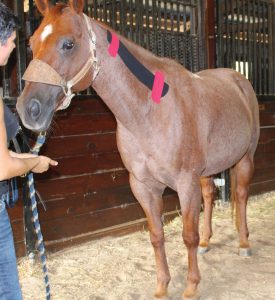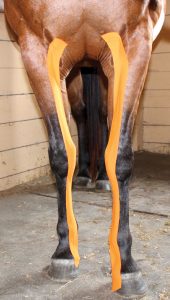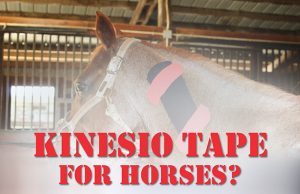EC_advertisng_RS200x345

Kinesio Tape For Horses? – When Muscles Need Extra Support
Click here to read the complete article
By Megan Arszman
All photos courtesy Dr. Angelique Barbara, Holistic Animal Studies
You can’t watch a sporting event nowadays without seeing top athletes and even Olympians sporting multi-colored tape that adorns their bodies with odd patterns. The tape isn’t a fashion statement. It’s kinesiology tape that has gained a lot of popularity in the past 10 years. Just as with most other therapeutic modalities for humans, it’s now just starting to gain traction for animal athletes.
Kinesiology Tape: Help or Hype?
Kinesiology is the scientific study of body movement. While duct tape is known to fix just about everything on the farm, it isn’t the same as kinesiology tape. However, kinesiology tape doesn’t contain anything special besides a sticky adhesive and elastic fabric. There’s no liniment and there’s no medicine. The tape was developed by a Japanese chiropractor in the late 1970s to be used much like a brace to provide support while not limiting movement. His goal for the tape was to be applied strategically along the lines of muscles and ligaments in the body to provide support, lessen pain, reduce swelling, and improve an athlete’s performance.
Anna Dunlap, DVM, CIVCA, grew up showing on the APHA and AQHA circuits and now travels around Central Kentucky as a general practitioner and owner of Creek Hollow Veterinary Services. She’s also certified to apply kinesiology tape on horses, dogs, and humans. She has seen a notable difference in her clients’ horses when the tape is applied; for a multitude of reasons. “The tape actually becomes like an external, flexible brace for horses,” Dr. Dunlap says.
Kinesiology tape is made of adhesive, cotton, and nylon, which makes it very stretchy and very sticky. Dr. Kenzo Kase, the inventor of the tape, wanted the tape to mimic the elasticity of the skin, thus allowing the user to have full range of motion but still be supported. When the tape is applied to the body along certain lines, the elasticity of the material helps to lift up the skin gently, creating a microscopic space between the skin and the tissues underneath. “You’re applying negative pressure to the inflammation,” explains Dr. Dunlap. “The effect is more like a suction.”
The negative pressure stimulates a process called angiogenesis, the formation of blood vessels or capillaries, which encourages blood flow to the injured area. More blood flow means increased healing time, thus reducing inflammation. In a study with human participants, when the kinesiology tape was applied over the knee or the shoulder, the slight space created in those two joints helped to reduce the chance of joint irritation.
The tissues of the human body (skin, connective tissue, fascia, and muscles) contain sensory receptors that can feel pain, temperature, and touch. When taped, the slight lift unloads the underlying tissues, which creates decompression and invites more blood flow to the area. Doubtful that a stretchy piece of tape could help to provide much support to a 1,000 pound animal? Consider how the decompression effect might even be amplified in horses that have such sensitive skin receptors that they can feel a tiny fly resting on their haunches.
Is it Legal or Appropriate in Competition?
Even though there’s no drug or additive used with kinesiology tape, the jury is still out when it comes to the use of the tape at a show or event. According to the United States Equestrian Federation (USEF), horses aren’t allowed to step out of their stall while wearing the tape; however, your horse can wear it while unsaddled and in the stable area. So far, there are no rules regarding the use of kinesiology tape in the AQHA or APHA rulebooks. However, practitioners and professionals are warned to abide by the USEF regulations and to use the therapeutic tape while horses are un-tacked and in the stable area only while at shows. If you have any questions, it’s always best to call your respective breed association to speak with an expert.
Because she’s located in Kentucky, Dr. Dunlap works with a variety of equestrian disciplines including racehorses, foxhunters, eventers, and even Western Pleasure horses. The type of application varies from horse to horse and discipline to discipline.
When certain muscles and/or joints need extra support, kinesiology tape can be an aid. Some studies have even shown that, when kinesiology tape is used properly, it can enhance movement and endurance of muscles, as well as help improve the performance of fatigued muscles. For horses that push more from behind, like Western Pleasure horses or Western Riding horses, the need to maintain a level topline while making lead changes can cause a lot of discomfort. Often, Dr. Dunlap will tape the entire back from the base of the withers to the croup for support along the entire spine.
“It depends on the size of the horse and the size of the rider,” Dr. Dunlap explains. “Reining horses tend to have short backs, yet they also tend to carry a heavier rider for their size. If that’s the case, then I will tape their lumbar area more for support and to aid in strengthening.”
Use for Enhancement
Many distance runners rely on using kinesiology tape more like an alarm of sorts to wake up their muscles, to aid in achieving peak performance, and protect against injury without the use of drugs. The same can be said for Reiners who might want to get another foot on their sliding stop. Sometimes, a little pelvic support is what you need to train a horse to that point, so that it becomes muscle memory.
Use for Swelling or Soreness Reduction
For Dr. Dunlap’s racehorses, she does a lot of lateral taping on the neck and vertebrae because soreness may be increased thanks to the pulling action that’s caused by going down the track. Western horses tend to be more sore at the nuchal ligament area, due to the dropping motion of the head at the withers. Horses that need to go in a more upright frame, like in Over Fence classes, flex more at the poll, so they need more relief and lifting with a little extra stretch in that area.
Reining horses often have more soreness in the lower back, due to how they reach under themselves for stops and spins, so Dr. Dunlap will tape across the lumbar region of the horse’s back and around the ribs so the lumbar muscles get more skeletal support.

Because Dr. Dunlap is familiar with the Western Pleasure circuit, she’s noticed a theme with her clients when it comes to increased soreness at shows. “I think Western horses tend to get more sore at shows because exhibitors pull out their larger, heavier saddles that have longer skirts and more silver,” she says. “Compare your show saddle to your work saddle, and you’ll see a noticeable difference in the weight and size of the saddle. I’ve done it myself. I had a Harris rough-out work saddle and a Blue Ribbon show saddle, and they fit my horse totally differently, and there was a big difference in their weight.”
Pleasure Driving and Hunter Under Saddle horses really sweep the ground with their legs, so they might see soreness in the hamstrings more than in other disciplines. It’s easy to see in Pleasure Driving horses, Dr. Dunlap explains, because they carry their load behind them, instead of on top. Jumpers, Reiners, Cutting, and Roping horses will see an increase in soreness in the hamstrings as well because of the springing action needed to lift off for a jump, the agility to spin and slide, and the quick side to side action required to cut cattle.
Dr. Dunlap has seen an increased use in kinesiology tape as a preventative while traveling to shows, as well. “A lot of our horses come from pretty far to get to the World Show or Congress. If they show up with lumps or bumps on their legs, there’s some anti-inflammatory taping you can do right over a swollen or stocked up spot,” she says. “At the World Show, they’re standing on concrete for two weeks, and their legs are getting swollen, so you can do some taping for anti-inflammatory that’s really effective.”
Application and Tips
If you’re familiar with applying kinesiology tape to yourself, Dr. Dunlap stresses that it’s important that you don’t stretch the tape on a horse as much as you would on a human. “I think one of the misconceptions happens because many of us are used to applying standing wraps. When doing a standing wrap, you pull the wrap tight, because you’re trying to squeeze the leg a little bit. That’s not at all what you want to do with the tape,” she says. “You’re just applying the tape in an almost no tension or minimal tension way. It should be applied in a way that the fabric contracts when the horse moves. That’s enough to stimulate the anti-inflammatory effect you’re going for. If you crank the tape and put any tension on it, you can put something into spasm and really mess up your day.”
Because of the sticky adhesive, the tape can be applied on a horse without the need to shave a particular spot. If you’re using tape specifically for horses, such as EquiTape, its adhesive is much stronger than the human version of the tape. Avoid using the tape when the horse is dirty or when he has been prepped for the show pen. The use of silicon sprays will negate any of the adhesive capabilities. If your horse is dirty or shedding, do your best to remove all of the loose hair and then use rubbing alcohol to wipe down and clean the area prior to applying the tape.
 Once the tape is applied, activate the adhesive by sliding across the tape with your hand for a few moments to warm it up. Then, you can leave it on as long as it’ll stick. “I’ll even trim the ends of the tape as it starts to come off the skin,” Dr. Dunlap suggests. “If you’re having trouble with the tape sticking, while there is a commercially available adhesive spray for the tape, I’ve found that Aquanet hairspray works just as well as anything, and what showman doesn’t have a can of Aquanet in their tack box?” Dr. Dunlap likes to apply Aquanet to the area she wants to tape, let it dry, and then apply tape over that area.
Once the tape is applied, activate the adhesive by sliding across the tape with your hand for a few moments to warm it up. Then, you can leave it on as long as it’ll stick. “I’ll even trim the ends of the tape as it starts to come off the skin,” Dr. Dunlap suggests. “If you’re having trouble with the tape sticking, while there is a commercially available adhesive spray for the tape, I’ve found that Aquanet hairspray works just as well as anything, and what showman doesn’t have a can of Aquanet in their tack box?” Dr. Dunlap likes to apply Aquanet to the area she wants to tape, let it dry, and then apply tape over that area. If you’re only applying the tape for a short period of time, for example three hours or a day after long travel, you may find it difficult to remove. Dr. Angelique Barbara of Holistic Animal Studies suggests spraying water on the tape, or even bathing the horse, so the water can soak into the adhesive. Then, roll the tape back onto itself. Do not pull it off like a Band-aid©. “Be aware that if the tape has only been used for a short amount of time, your horse can be sensitive to the pulling, and it can hurt,” she warns.
If you’re using the tape to help with soreness or swelling, experts suggest that sometimes the tape be left off the horse for a couple of days so you can evaluate how he’s moving, and if he’s improving at all. Note that depending on what part of your horse is being taped, it can be left on for several days. However, the length of time used with the tape doesn’t necessarily mean a better outcome.
Don’t Try this Alone
Dr. Dunlap reminds her clients and those interested in kinesiology tape that while there are YouTube videos on how to apply the tape to yourself, and to horses, it’s important that you work with a certified taping practitioner, chiropractor, massage therapist, or your own general practitioner to pinpoint any issues that might be present and to determine if taping might be of any help. Horse owners can find certified practitioners online or even learn how to tape their own horses by enrolling in classes and seminars.
It’s Wonderful, but it’s Not a Miracle Worker
Kinesiology tape has been helpful for so many athletes, two- and four-legged, but it doesn’t take the place of proper care and maintenance of the athlete, nor natural ability and training. “It’s not for concealing a lameness,” Dr. Dunlap points out. “It’s not going to change anything internally. Things like this help maybe 10 percent, which is sometimes all you need to train or show a horse to the place where you want to be. However, there’s nothing in a box or bottle that will make your horse lope like Harley D Zip. You don’t want to cover your horse in kinesiology tape and think that it’ll solve all their problems.”
Recently Added
- Stall Charts for 2025-2026 Florida Gold & Gulf Coast Shows, and Ugly Sweater Extravaganza December 18, 2025
- EC Photo of the Day — For a Reason December 18, 2025
- Around the Rings — 2025 Holiday ShoDown by ShoMe Horse Shows December 17, 2025
- EC Video of the Day – Matchy, Matchy December 17, 2025
- EC Photo of the Day — Cherish is the Word December 17, 2025
- 2026 Chrome Cash Matching Funds Heading to 16 Shows December 17, 2025
- Winter Tips For Your Horse — Straight from the DVM December 17, 2025
- 2025 ABRA Honor Roll Winners December 17, 2025
- Masterson Farms LLC Announces Passing of Brandys Silver Sheik, 2000-2025 December 16, 2025
- APHA Breeders’ Trust Stakes Class Enrollment Due Dec. 31, 2025 December 16, 2025
Archives
Sign In
Equine Chronicle ® All Rights Reserved. Copyright © 2025
4727 NW 80th Ave. • Ocala, FL 34482 • 352 369 1104 • FAX 352 369 1521
Privacy Policy | Questions, please contact The Equine Chronicle
-












